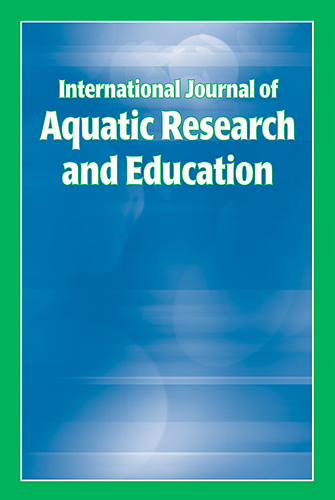Home > Journals > IJARE > Vol. 13 > No. 1 (February 2021)
Volume 13, Number 1 (February 2021)
In This Issue (13:1)
Welcome to the first issue of our Volume 13 of the International Journal of Aquatic Research and Education.I am thrilled to note that the number of full-text downloads of the previous 12 volumes (and 48 issues) of IJARE is rapidly approaching 150,000 in the past 4 years since we became an online, open access serial publication!. As I have written before, I find it virtually UNBELIEVABLE, but ever so gratifying that there has been so much interest in our focus on non-competitive aquatics, swimming, water safety, lifeguarding, water exercise, and related topics!
I also am reminding all our authors and readers that one advantage of publishing in IJARE using the bepress Scholarworks platform is that each article keeps a running log of how many times that article has been viewed and how many full text downloads have occurred. For any authors who may not have realized this statistic was available, you simply need to log on to http://scholarworks.bgsu.edu/IJARE and then identify in which volume and issue a paper appears. You can then open the title link and in the right hand corner under the blue "download" button, you will see how many views and downloads any paper has instigated. This statistic is especially important for young academic scholars who need to demonstrate how productive their specific lines of inquiry have been. Along with citation indices, total downloads are a powerful and direct indicator of the impact your paper has generated world wide. It is exciting stuff!
Research Articles
I am pleased to introduce the first research article in this first issue of the 13th volume of IJARE which comes from a fine group of authors, Chris Button, Angela J. Button, Anne-Marie Jackson, Jim D. Cotter (all from the University of Otago), and Brian Maraj (University of Alberta). This article, "Teaching Foundational Aquatic Skills to Children in Open Water Environments," is an especially important one because it is one of the first as well as most comprehensive studies to explore how well water competence may transfer from one aquatic environment (e.g., pools) to another (i.e., open water). I highly recommend reading and studying this paper!
The second research article comes from Portugal and an international group of authors who actively are studying the performance of Portuguese beach lifeguards. The study, " Portuguese Lifeguards Performance in Aquatic Rescue: An Exploratory Study," was authored by Olga G. Marques (University of Coimbra), José Palacios-Aguilar (University of A Coruña, Spain), Henrique G. Melo and Nuno G. Leitão (both from Portuguese Navy), Lucia P. Castillo (University of Vigo), David Szpilman (Brazilian Lifesaving Society- SOBRASA), and Luís Rama (University of Coimbra). Professional certification of lifeguards is fairly recent in Portugal and this study examined the quality of their rescue performance.
A third research article in this issue, "Calculating an Equation to Estimate the Maximum Oxygen Uptake in Lifeguards," came from a Spanish research team of aquatic researchers including Brais Ruibal-Lista (Universidade da Coruña), José Palacios-Aguilar (University of A Coruña,), José Antonio Prieto (University of Oviedo, Sergio López-García (Pontifical University of Salamanca), Miguel Santiago-Alonso (Universidade da Coruña), José Antonio Cecchini-Estrada (University of Oviedo), and Cristian Abelairas-Gómez (Universidade de Santiago de Compostela). This article follows up on a previously published study in Volume 11, Issue 3. This study deals with the statistical validation of the equation they developed to calculate VO2 max among lifeguards.
The fourth research paper reviews water and land walking and running both in forward and backward directions. The authors, Mostafa Yaghoubi, Philip Fink, Wyatt H. Page, and Sarah P. Shultz, all from Massey University, Wellington, New Zealand, composed "Biomechanical Properties of Land Based and Shallow Water Walking: A Comparative Review of Literature." Readers interested in aquatic exercise will find this paper especially interesting.
The fifth research article in this issue, "Changes in Lifeguards’ Hazard Detection and Eye Movements with Experience: Is One Season Enough?" authored by Jennifer Smith (University of Chichester), Geoff Long (University of Portsmouth), Peter Dawes (Royal National Lifeboat Institution), Oliver Runswick (University of Chichester), and Michael J. Tipton (University of Portsmouth) has explored an important and timely question in lifeguarding, namely the amount of practical experience required for lifeguard candidates to effectively detect aquatic hazards. It is especially pertinent for lifeguard training agencies and I believe will make a crucial contribution to the literature.
Educational Article
The first educational article in this issue was authored by Alena Gadberry (Gadberry Education Services) and James Gadberry (Athens State University). It was entitled, " Black Drowning Deaths: An Introductory Analysis. The authors have composed an excellent article that examines the many cultural and social aspects underlying the higher rates of drowning among African Americans. I recommend it as an interesting read!
Research Articles
Teaching Foundational Aquatic Skills to Children in Open Water Environments
Chris Button, Angela J. Button, Anne-Marie Jackson, Jim D. Cotter, and Brian Maraj
Portuguese Lifeguards Performance in Aquatic Rescue: An Exploratory Study
Olga G. Marques Ph.D., José Palacios-Aguilar Ph.D, Henrique G. Melo Mcs., Nuno G. Leitão, Lucia P. Castillo MSc., David Szpilman M.D, and Luís Rama Ph.D.
Calculating an Equation to Estimate the Maximum Oxygen Uptake in Lifeguards
Brais Ruibal-Lista, José Palacios-Aguilar, José Antonio Prieto, Sergio López-García, Miguel Santiago-Alonso, José Antonio Cecchini-Estrada, and Cristian Abelairas-Gómez
Changes in Lifeguards’ Hazard Detection and Eye Movements with Experience: Is One Season Enough?
Jennifer Smith, Geoff Long, Peter Dawes, Oliver Runswick, and Michael J. Tipton
Who are the Older Adults Who Drown in Western Australia? A Cluster Analysis Using Coronial Drowning Data.
Meg Abercromby, Dr Justine E. Leavy, Lauren Nimmo, and Dr Gemma Crawford
Education Article
Black Drowning Deaths: An Introductory Analysis
Alena Gadberry and James Gadberry
Scientific Literature Review
Biomechanical Properties of Land Based and Shallow Water Wait: A Comparative Review of Literature
Mostafa Yaghoubi, Philip Fink, Wyatt H. Page, and Sarah P. Shultz
